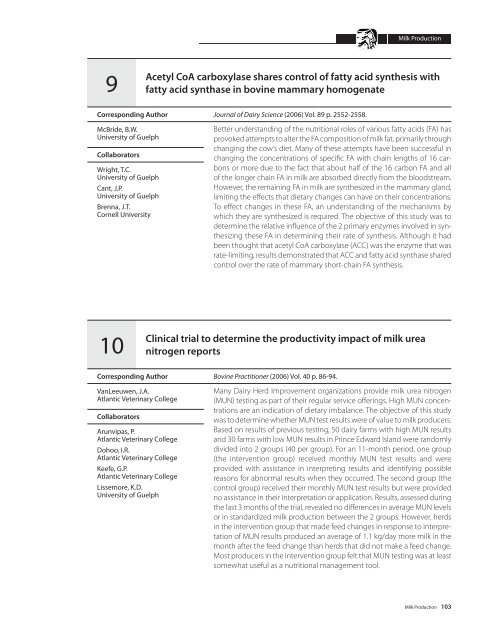A52-75-2007E.pdf - AgroMedia International Inc
A52-75-2007E.pdf - AgroMedia International Inc
A52-75-2007E.pdf - AgroMedia International Inc
You also want an ePaper? Increase the reach of your titles
YUMPU automatically turns print PDFs into web optimized ePapers that Google loves.
Milk Production9Acetyl CoA carboxylase shares control of fatty acid synthesis withfatty acid synthase in bovine mammary homogenateCorresponding AuthorMcBride, B.W.University of GuelphCollaboratorsWright, T.C.University of GuelphCant, J.P.University of GuelphBrenna, J.T.Cornell UniversityJournal of Dairy Science (2006) Vol. 89 p. 2552-2558.Better understanding of the nutritional roles of various fatty acids (FA) hasprovoked attempts to alter the FA composition of milk fat, primarily throughchanging the cow’s diet. Many of these attempts have been successful inchanging the concentrations of specific FA with chain lengths of 16 carbonsor more due to the fact that about half of the 16 carbon FA and allof the longer chain FA in milk are absorbed directly from the bloodstream.However, the remaining FA in milk are synthesized in the mammary gland,limiting the effects that dietary changes can have on their concentrations.To effect changes in these FA, an understanding of the mechanisms bywhich they are synthesized is required. The objective of this study was todetermine the relative influence of the 2 primary enzymes involved in synthesizingthese FA in determining their rate of synthesis. Although it hadbeen thought that acetyl CoA carboxylase (ACC) was the enzyme that wasrate-limiting, results demonstrated that ACC and fatty acid synthase sharedcontrol over the rate of mammary short-chain FA synthesis.10Clinical trial to determine the productivity impact of milk ureanitrogen reportsCorresponding AuthorVanLeeuwen, J.A.Atlantic Veterinary CollegeCollaboratorsArunvipas, P.Atlantic Veterinary CollegeDohoo, I.R.Atlantic Veterinary CollegeKeefe, G.P.Atlantic Veterinary CollegeLissemore, K.D.University of GuelphBovine Practitioner (2006) Vol. 40 p. 86-94.Many Dairy Herd Improvement organizations provide milk urea nitrogen(MUN) testing as part of their regular service offerings. High MUN concentrationsare an indication of dietary imbalance. The objective of this studywas to determine whether MUN test results were of value to milk producers.Based on results of previous testing, 50 dairy farms with high MUN resultsand 30 farms with low MUN results in Prince Edward Island were randomlydivided into 2 groups (40 per group). For an 11-month period, one group(the intervention group) received monthly MUN test results and wereprovided with assistance in interpreting results and identifying possiblereasons for abnormal results when they occurred. The second group (thecontrol group) received their monthly MUN test results but were providedno assistance in their interpretation or application. Results, assessed duringthe last 3 months of the trial, revealed no differences in average MUN levelsor in standardized milk production between the 2 groups. However, herdsin the intervention group that made feed changes in response to interpretationof MUN results produced an average of 1.1 kg/day more milk in themonth after the feed change than herds that did not make a feed change.Most producers in the intervention group felt that MUN testing was at leastsomewhat useful as a nutritional management tool.Milk Production 103





